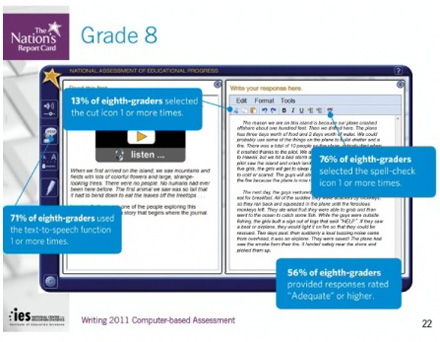by Dana Grisham and Jill Castek
Results of the 2011 National Assessment of Educational Progress (NAEP) computer-based writing assessment, administered to students in grades 8 and 12 throughout the United States, are now available. The NAEP assessments have occurred since 1969 and provide a reliable snapshot of educational progress in the U.S.
The 2011 writing assessment is the first one that has used technology as part of the assessment. Because of this, new scales and achievement levels were established, which means the findings cannot be directly compared to past years’ results. Preliminary findings suggest however that students in 8th and 12th grades have a similar pattern of achievement as revealed in the past by pencil and paper tests. At both 8th and 12th grades, only about 24% of students assessed scored at the “proficient” level. About half the students scored at the “basic” achievement level.
A Closer Look at the NAEP Writing Assessment
The types of writing required of students on the NAEP assessment aligns with the Common Core State Standards and stresses the reinforcement of three writing capacities: persuasion, explanation, and conveying an experience. Scores on the NAEP assessment were based on six performance ratings and scored as “first drafts” rather than polished writing samples. The full set of ratings and results may be found in the report.
Writing prompts were displayed on a computer screen divided vertically like the pages of a book (see figure 1). The left half contained the prompt with specific types of multimedia, including an audio prompt at 8th grade and a video prompt at the 12th grade. For 12th graders the technology was a little more sophisticated, as the prompt included video as well as audio. Adhering to the principles of Universal Design for Learning, there were a number of digital tools that students could elect to use as they word-processed their response. Students who used the tools available (cut/paste, text-to-speech, spell check, thesaurus) scored higher than students who did not use these tools.
Figure 1. The 8th grade writing prompt included an audio file (on the left). On the right, students word processed their responses. Digital enhancements included the text-to-speech function, spell check features, and copy and paste, and thesaurus).

Implications
For all educators, there is an urgent need to embrace technological tools for communication and composition in our homes and schools. Questionnaires were given to teachers of 8th grade students completing the NAEP writing assessment. The survey asked how frequently they had students using computers to write and revise drafts.Only 44% reported using technology regularly to further writing instruction. Students of these teachers scored higher than those whose teachers did not use technology as often in writing instruction. Both 8th and 12th grade students who said they used a computer more frequently to edit their writing scored higher than students who did not.
Luckily, there are an increasing number of resources for learning about and using technological tools in the classroom. See for example, the Literacy Beat blog, Transforming writing instruction in the Digital Age: Techniques for Grades 5-12, and The Digital Writing Workshop.
Recommendations
Given the results of the NAEP writing assessment, we have ventured to suggest some recommendations for educators.
Teachers need to:
1. Find ways to incorporate technology into their classrooms with the tools (however limited) that they already have.
2. Argue on behalf of technology, using the research evidence at hand—such as the 2011 NAEP Writing Assessment outcomes.
3. Seek workshops and professional development opportunities to develop their own expertise in technology use.
Administrators need to:
1. Support teachers’ use of technology in the classroom.
2. Argue at the district level on behalf of technology use.
3. Seek workshops and professional development opportunities for themselves and their teaching staff.
Teacher Educators need to:
1. Work collaboratively within the university to distribute technological use across the teacher preparation programs instead of relying on “Ed Tech” courses.
2. Seek workshops on technology use for themselves.
3. Where possible, seek student teaching placements for teacher candidates where technology is being used productively.
Dr. Dana L. Grisham (dana.grisham@gmail.com) is Certified Core Adjunct Faculty of National University, is noted for her research on teaching, particularly the intersection of literacy and technology. Jill Castek (jill.castek@gmail.com) is a Research Assistant Professor at Portland State University working with the Literacy, Language, and Technology Research Group.
This article is part of a series from the International Reading Association Technology in Literacy Education Special Interest Group (TILE-SIG).